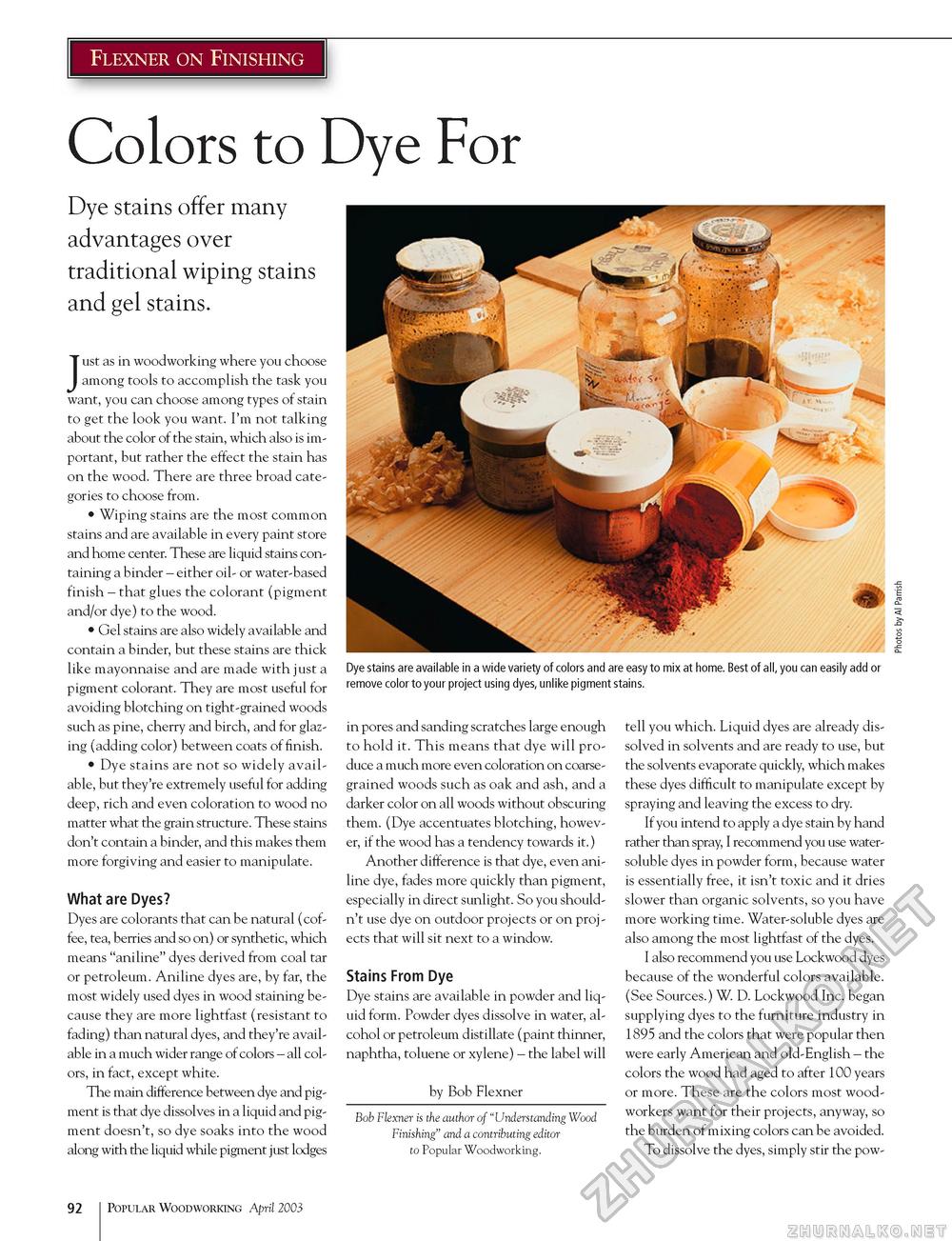Popular Woodworking 2003-04 № 133, страница 92
Flexner on Finishing Colors to Dye For Dye stains are available in a wide variety of colors and are easy to mix at home. Best of all, you can easily add or remove color to your project using dyes, unlike pigment stains. Dye stains offer many advantages over traditional wiping stains and gel stains. Just as in woodworking where you choose among tools to accomplish the task you want, you can choose among types of stain to get the look you want. I'm not talking about the color of the stain, which also is important, but rather the effect the stain has on the wood. There are three broad categories to choose from. • Wiping stains are the most common stains and are available in every paint store and home center. These are liquid stains containing a binder - either oil- or water-based finish - that glues the colorant (pigment and/or dye) to the wood. • Gel stains are also widely available and contain a binder, but these stains are thick like mayonnaise and are made with just a pigment colorant. They are most useful for avoiding blotching on tight-grained woods such as pine, cherry and birch, and for glazing (adding color) between coats of finish. • Dye stains are not so widely available, but they're extremely useful for adding deep, rich and even coloration to wood no matter what the grain structure. These stains don't contain a binder, and this makes them more forgiving and easier to manipulate. What are Dyes? Dyes are colorants that can be natural (coffee, tea, berries and so on) or synthetic, which means "aniline" dyes derived from coal tar or petroleum. Aniline dyes are, by far, the most widely used dyes in wood staining because they are more lightfast (resistant to fading) than natural dyes, and they're available in a much wider range of colors - all colors, in fact, except white. The main difference between dye and pigment is that dye dissolves in a liquid and pigment doesn't, so dye soaks into the wood along with the liquid while pigment just lodges in pores and sanding scratches large enough to hold it. This means that dye will produce a much more even coloration on coarsegrained woods such as oak and ash, and a darker color on all woods without obscuring them. (Dye accentuates blotching, however, if the wood has a tendency towards it.) Another difference is that dye, even aniline dye, fades more quickly than pigment, especially in direct sunlight. So you shouldn't use dye on outdoor projects or on projects that will sit next to a window. Stains From Dye Dye stains are available in powder and liquid form. Powder dyes dissolve in water, alcohol or petroleum distillate (paint thinner, naphtha, toluene or xylene) - the label will by Bob Flexner Bob Flexner is the author of "Understanding Wood Finishing" and a contributing editor to Popular Woodworking. tell you which. Liquid dyes are already dissolved in solvents and are ready to use, but the solvents evaporate quickly, which makes these dyes difficult to manipulate except by spraying and leaving the excess to dry. If you intend to apply a dye stain by hand rather than spray, I recommend you use water-soluble dyes in powder form, because water is essentially free, it isn't toxic and it dries slower than organic solvents, so you have more working time. Water-soluble dyes are also among the most lightfast of the dyes. I also recommend you use Lockwood dyes because of the wonderful colors available. (See Sources.) W. D. Lockwood Inc. began supplying dyes to the furniture industry in 1895 and the colors that were popular then were early American and old-English - the colors the wood had aged to after 100 years or more. These are the colors most woodworkers want for their projects, anyway, so the burden of mixing colors can be avoided. To dissolve the dyes, simply stir the pow- 92 Popular Woodworking April 2003 |








